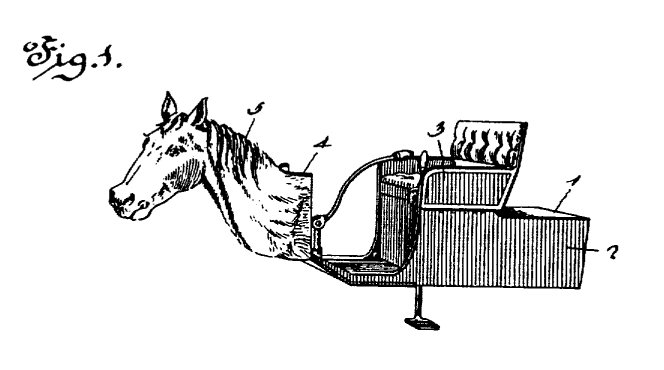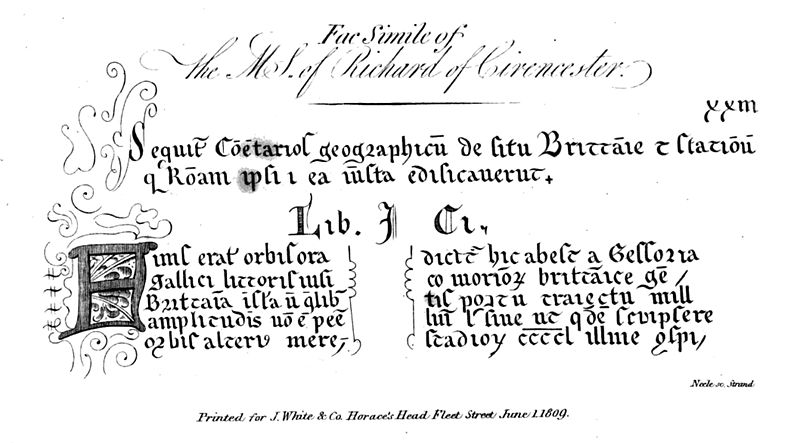
Michigan inventor Uriah Smith patented the Horsey Horseless in 1899. He hoped that an automobile that bore a wooden horse’s head would be less likely to spook animals in the road.
For all we know he was right. Maybe we should still be using these.

Michigan inventor Uriah Smith patented the Horsey Horseless in 1899. He hoped that an automobile that bore a wooden horse’s head would be less likely to spook animals in the road.
For all we know he was right. Maybe we should still be using these.
A problem from the October 1959 issue of Eureka, the journal of the Cambridge University Mathematical Society:
A. The total number of true statements in this problem is 0 or 1 or 3.
B. The total number of true statements in this problem is 1 or 2 or 3.
C. The total number of true statements in this problem (excluding this one) is 0 or 1 or 3.
D. The total number of true statements in this problem (excluding this one) is 1 or 2 or 3.
Which of these statements are true?
On the afternoon of June 28, 1914, Stefan Zweig was on holiday in Baden, reading an essay in the Kurpark, while
the wind in the trees, the twittering of the birds and the music floating across from the park were at the same time part of my consciousness. I could clearly hear the melodies without being distracted, for the ear is so adaptable that a continuous noise, a roaring street, a rushing stream are quickly assimilated into one’s awareness; only an unexpected pause in the rhythm makes us prick our ears … Suddenly the music stopped in the middle of a bar. I didn’t know what piece they had played. I just sensed that the music had suddenly stopped. Instinctively, I looked up from my book. The crowd, too, which was strolling through the trees in a single flowing mass, seemed to change; it, too, paused abruptly in its motion to and fro. Something must have happened.
Word had just arrived that the archduke of Austria had been assassinated in Sarajevo.
(Quoted in Christopher Clark, The Sleepwalkers, 2013.)
By science fiction author Larry Niven:
1.a. Never throw shit at an armed man.
1.b. Never stand next to someone who is throwing shit at an armed man.
2. Never fire a laser at a mirror.
3. Mother Nature doesn’t care if you’re having fun.
4. F × S = k. The product of Freedom and Security is a constant. To gain more freedom of thought and/or action, you must give up some security, and vice versa.
5. Psi and/or magical powers, if real, are nearly useless.
6. It is easier to destroy than create.
7. Any damn fool can predict the past.
8. History never repeats itself.
9. Ethics change with technology.
10. There ain’t no justice.
11. Anarchy is the least stable of social structures. It falls apart at a touch.
12. There is a time and place for tact. And there are times when tact is entirely misplaced.
13. The ways of being human are bounded but infinite.
14. The world’s dullest subjects, in order:
a. Somebody else’s diet.
b. How to make money for a worthy cause.
c. Special Interest Liberation.
15. The only universal message in science fiction: There exist minds that think as well as you do, but differently. (Niven’s corollary: The gene-tampered turkey you’re talking to isn’t necessarily one of them.)
16. Never waste calories (i.e., don’t eat food just because it’s available, or cheap; only eat food you’ll enjoy, because you have to limit overall calorie intake).
17. There is no cause so right that one cannot find a fool following it.
18. No technique works if it isn’t used.
19. Not responsible for advice not taken.
20. Old age is not for sissies.
See Lessons Learned.

Marked by its face and call, the turaco Crinifer personatus of East Africa is known as the bare-faced go-away bird.
This seems unfair. Hummingbirds get names such as royal sunangel, empress brilliant, blue-chinned sapphire, golden-crowned emerald, and shining sunbeam.
“One tends not to want to devote much energy to tracking down birds with names such as the unadorned flycatcher, drab water-tyrant, grayish mourner or one-colored becard,” writes birder William Young. “In Costa Rica, I saw a tiny (albeit friendly) drab bird with the oxymoronic name of paltry tyrannulet.”
(William Young, “Words of a Feather,” Word Ways 32:4 [November 1999], 297-299.)
A striking detail from the Encyclopaedia Britannica of 1860: On a wager, poet John Taylor (1578–1653) once engaged to row from London to Queenborough in a paper boat with two stockfish tied to canes for oars. He partnered with a vintner named Roger Bird, and the two
Took ship vpon the vigill of Saint Iames
And boldly ventur’d down the Riuer Thames,
Lauing and cutting through each raging billow,
(In such a Boat which neuer had a fellow)
Hauing no kinde of mettall or no wood
To helpe vs eyther in our Ebbe or Flood:
For as our boat was paper, so our Oares
Where Stock-fish, caught neere to the Island shores.
The boat began to leak and founder, and Taylor contrived to hold it up by attaching eight inflatable bullocks’ bladders to its sides. After two miserable days, he and Bird reached their goal and were feted by the mayor of Queenborough while the people tore the boat to scraps, “Wearing the reliques in their hats and caps.” They rode home on horseback.

The cover of Wolfgang Haug’s 1986 book Critique of Commodity Aesthetics bears a striking photo — when corn was strategically spread in in St. Mark’s Square in Venice, hundreds of feasting pigeons produced an impromptu advertisement for Coca-Cola.
Evidently Coke had borrowed the idea from Assicurazioni Generali, a Venetian insurance company with headquarters in the piazza. The insurers would coax the pigeons to form the letters A G.
I’m not sure when the Coke ad was made. In The Postmodern Arts: An Introductory Reader (1995), Nigel Wheale says the ad could be seen on the walls of Italian bars and restaurants in the late 1960s, but possibly the photo had been taken earlier.
Called on to give an after-dinner talk at a 1961 meeting, Los Alamos physicist Darol Froman proposed a new project “without much attention to some of the practical aspects”: What if we turned Earth into a giant spaceship and drove it around? If we built a fusion rocket and fed it the moon and some damp sand, it could (in principle) carry us out of orbit. Our atmosphere would protect us from interstellar radiation, and we’d be free of the worry of our sun’s impending death.
It might take 100 million years to make our way out of the solar system, but by accelerating smoothly and sacrificing 4 percent of the planet’s mass we might have enough fuel to travel for 8 billion years. We could harvest deuterium from the oceans to generate heat and light during the journey, which might cover 1,300 light-years, and if we can refuel (“i.e., fill an ocean or two”) at hospitable planets then we might continue in this way indefinitely, exploiting the pull of stars along our path to help with navigation.
“I predict a pleasant existence in space — we will get away from the daily grind,” he said. “Perhaps we shall not wish to join another star — life in space may be more desirable.”
(He added, “I haven’t yet figured out a good way to leave certain people behind. It has been suggested that we use them for propellant. The human body is not constituted with quite as good proportions of the elements for our propellant as is damp sand. Nevertheless, the proportions are not too bad and we can in this way take care of the problem of overpopulation.”)
(Darol Froman, “The Earth as a Man-Controlled Space Ship,” Physics Today 15:7 [July 1962], 19-23.)
The weather was unprecedented — weeks of damp and rain and fog. Everybody talked about it. One day during that spell I was holding forth to a practical farmer on the subject of hay. Full of book learning, I was explaining (rather too glibly) the advantages of cutting hay in June. I described in detail the vitamin loss incurred by letting hay stand in the field after it has matured, and how much greater the feed value was per unit weight in early-cut hay, even though the quantity might be slightly less. The farmer was a quiet man, with big hands for curling round a scythe handle. He listened attentively. My words swirled around his head like summer flies. Finally, when I had exhausted my little store of learning and paused for a moment, he ventured a reply.
‘The time to cut hay,’ he said firmly, ‘is in hayin’ time.’
— E.B. White, “Book Learning,” 1942

Charles Bertram built his reputation as a historian on The Description of Britain, a 15th-century manuscript that he’d discovered at age 24 and that provided important new insights into British history, including an ancient map; more than a hundred names of cities, roads, and people; and information from a lost contemporary account by a Roman general. For more than a century Bertram’s discovery served as a touchstone of scholarship on Roman Britain — it was cited in Gibbon’s Decline and Fall of the Roman Empire, among many other works.
After Bertram’s death in 1765 doubts began to mount, and by 1846 it was clear that The Description of Britain had been a forgery. Bertram had managed to convince a few influential librarians, and on the strength of their endorsement other historians had been willing to take the claim seriously. Bertram had never let anyone see the original manuscript, always inventing reasons why he couldn’t share it and sending instead facsimiles of the original.
The effects of the hoax took decades to eradicate — as late as 1911 the Encyclopædia Britannica was still referring to a fictitious naval base on the strength of the Description‘s account.